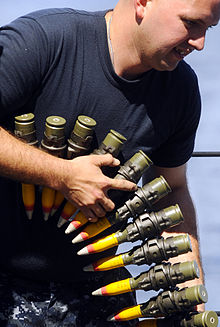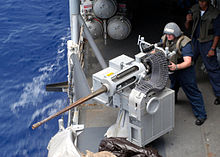- M242 Bushmaster
-
"M242" redirects here. For the Israeli Jeep derivative, see AIL Storm#Storm II.
M242 Bushmaster 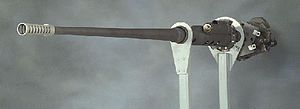
U. S. Army photographType Chain gun Place of origin United States Service history In service 1972–present Used by See operators Production history Designer McDonnell Douglas Manufacturer Alliant Techsystems Number built 10,500+ Specifications Weight 119 kilograms (260 lb) Barrel length • Overall: 2,672 mm (105.2 in)
• Bore: 2,175 mm (85.6 in)Shell 25×137 mm Caliber 25 millimetres (0.98 in) caliber Barrels Single barrel (progressive RH parabolic twist) Rate of fire • Cyclic: 200 rounds per minute Muzzle velocity 1,100 metres per second (3,600 ft/s) Effective range 3,000 metres (9,800 ft) Maximum range 6,800 metres (22,300 ft) The M242 Bushmaster is a 25 mm (25×137mm) chain-fed autocannon. It is used extensively by the US armed forces, as well as by NATO's and some other nations' forces in ground combat vehicles and watercraft. Originally, the weapon was designed and manufactured by McDonnell Douglas (later acquired by the Boeing Corporation); however it is now produced by Alliant Techsystems (ATK) of Mesa, Arizona.
It is an externally powered, chain driven, single-barrel weapon which may be fired in semi-automatic or automatic modes. It is fed by a metallic link belt and has dual-feed capability. The term "chain gun" derives from the use of a roller chain that drives the bolt back and forth. The gun can destroy lightly armored vehicles and aerial targets (such as helicopters and slow-flying aircraft). It can also suppress enemy positions such as exposed troops, dug-in positions, and occupied built-up areas. The standard rate of fire is 180 rounds per minute. The weapon has an effective range of 3,000 metres (9,800 ft), depending on the type of ammunition used.
Contents
History
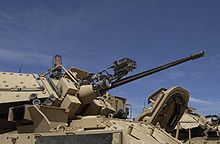 The Enhanced M242 on the M2 Bradley (the top-mounted metal box and spotlight are MILES training attachments, not part of the gun system). Note the fluted barrel.
The Enhanced M242 on the M2 Bradley (the top-mounted metal box and spotlight are MILES training attachments, not part of the gun system). Note the fluted barrel.
The Bushmaster project started as an offshoot of the US Army's MICV-65 program that was attempting to introduce a new infantry fighting vehicle to replace their existing M113s. Part of this program called for a new scout vehicle to replace the M114, a parallel development taking place under the XM800 Armored Reconnaissance Scout Vehicle. Both the XM800 and the cavalry version of the XM701 MICV vehicles were armed with the M139, a US-built version of the Hispano-Suiza HS.820 20 mm autocannon.
During the testing phase the Army eventually rejected the XM701 and started work on a newer design known as the XM723. Soon after the XM800 was also rejected. This led to the combination of the two programs, moving the scout role to the cavalry version of the XM723.
At the same time, the M139 proved to be disappointing and a contract for a new weapon to replace it started in 1972 at Hughes Aircraft as the Vehicle Rapid-Fire Weapons System-Successor, or VRFWS-S. This was essentially a power-driven gun firing similar ammunition as the HS.820, the power driven mechanism would ensure operation even in the case of a misfire.
Progress on the VRFWS-S was slow, and eventually resulted in a switch to a much more powerful 25 mm round. Similar delays in the MICV program meant the ultimate vehicles descending from their efforts, the M2/M3 Bradley Fighting Vehicle, did not enter production until 1981, by which point the Bushmaster had matured. Since 1990, there have been several enhancements made upon the weapon, resulting in the Enhanced 25 mm gun.
To date, more than 10,500 weapons are in service. One of the major reasons for this popularity is the extremely reliable nature of the weapon. It has a rating of 22,000 mean rounds between failure (MRBF), much higher than many comparable devices.
Description
Unlike most automatic firearms, the M242 does not depend on gas or recoil to actuate its firing system. Instead, it uses a 1 hp (0.75 kW) DC motor, positioned in the receiver to drive the chain and dual-feed system. This system uses sprockets and extractor grooves to feed, load, fire, extract, and eject rounds. A system of clutches provides for an alternate sprocket to engage and thus allows the gunner to switch between armor piercing and high explosive rounds.
The weapon assembly consists of three parts: the barrel assembly, the feeder assembly, and the receiver assembly. The three-part structure makes it possible for a single person to install or remove the system despite its considerable total weight.
The M242 weapon system has both electrical and manual fire control and can be operated electrically or manually. In doing so, the gunner can choose from three rates of fire: (1) Single Shot Semi-Automatic, in which the gunner can shoot as fast as the trigger can be operated; (2) Low Rate Fully Automatic, in which the weapon fires 100 rounds a minute, plus or minus 25 rounds; and (3) High Rate Fully Automatic, in which the weapon fires 200 rounds a minute, plus or minus 25 rounds.
Ammunition
A wide range of ammunition has been developed for this weapon, providing it with the capability to defeat the majority of armored vehicles it is likely to encounter, up to and including some tanks. The ammunition used in the M242 may also be used in a variety of weapons such as the GAU-12 Equalizer, the French Giat M811, or the Swiss Oerlikon KBA weapon system. It has the capability to fire U.S. manufactured ammunition as well as the NATO equivalents thereof. Primarily though, it fires six types of rounds: the M791, M792, M793, M910, MK210, and M919.
- M791 Armor Piercing Discarding Sabot with Tracer
- 5.7 million rounds produced
- The APDS-T penetrates lightly armored vehicles, self-propelled artillery, and aerial targets such as helicopters and various slow-moving, fixed-wing aircraft.
- M792 High Explosive Incendiary with Tracer and Self Destruct
- 5.5 million rounds produced
- The HEI-T can destroy unarmored vehicles and helicopters and suppress antitank missile positions and enemy squads out to a maximum effective range of 3,000 meters.
- M793 Target Practice with Tracer
- 11.5 million rounds produced
- The TP-T cartridge is a fixed-type, percussion-primed training round that matches the High Explosive Incendiary with Tracer (HEI-T MK210) round ballistically. The TP-T's tracer is visible out to 2,000 meters, however, the round has a maximum effective range (accuracy-limited) of 1,600 meters.
- M910 Target Practice Discarding Sabot with Tracer
- The TPDS-T replicates the flight pattern of the M791 Armor Piercing Discarding Sabot with Tracer (APDS-T) round. The TPDS-T allows units to realistically practice sabot engagements.
- MK210 High Explosive Incendiary with Tracer
- 228,000 rounds produced
- Used by the U. S. Navy in their Mk38 naval weapon system.
- M919 Armor-Piercing, Fin-Stabilized Discarding Sabot With Tracer.
- The APFSDS-T round penetrates light armored vehicles, self-propelled artillery, and aerial targets, which includes helicopters and slow-moving fixed-wing aircraft. It is identical to the M791 Armor Piercing Discarding Sabot with Tracer except in its quality of being fin-stabilized, and that the dart is made of depleted uranium.
Variations
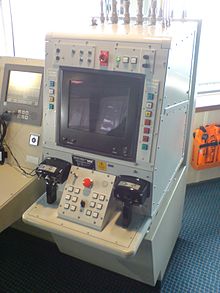 Weapons station for the remote controlled M242 on the HMNZS Canterbury multi-role vessel.
Weapons station for the remote controlled M242 on the HMNZS Canterbury multi-role vessel.
The M242 is currently in use by the United States Army, Navy, Marine Corps, and Coast Guard, the New Zealand Army, Royal New Zealand Navy, the Norwegian Army, the Spanish Army, the Swiss Army, the Canadian Army, the Australian Army and Navy, the Israeli Navy, Philippine Navy, the Singapore Army and Republic of Singapore Navy as well as several others. The wide usage results in several variations and modifications on the standard M242 weapon system.
Ground Vehicles
The M242 is standard equipment on the U. S. Army M2 and M3 Bradley fighting vehicles, it is also in use on the LAV-25. Before the project was cancelled, the Bushmaster II 30 mm chain gun (a successor to the M242) was used on the Marine Corps' Expeditionary Fighting Vehicle (EFV).
The M242 is also a popular choice of primary armament for armoured fighting vehicles manufactured around the world, such as Singapore's Bionix AFVs and as the Rafael OWS-25 mounted on upgraded M113A2 Ultra IFVs.[1]
Enhanced 25 mm gun
Work on an upgraded weapon began in 1990. In doing so, three major systems and seven minor systems were improved. The modifications began with introducing a chrome-lined barrel, an enhanced feeder, and an enhanced receiver. The weapon systems also received minor upgrades such as quick-detachable link covers, a larger breech assembly, a high efficiency muzzle brake, longer recoil, an integral round counter, an extended life firing pin and spring, and a triple-spring drive clutch. It was first put to use on the M2A3 Bradley, the third version of the M2 Bradley Fighting Vehicle.
Aircraft
The M242 is not used on aircraft. The AC-130U and the AV-8 Harrier II uses a different 25 mm caliber weapon, the 5-barreled GAU-12/U. The sister weapon of the M242, the 30 mm caliber M230 Chain Gun, is standard equipment on the Boeing AH-64 Apache attack helicopter.
In 1977, the U. S. Navy realized that it needed a replacement for the Oerlikon/Hispano-Suiza 20mm Mk 16 series of guns. In 1986, this requirement was satisfied with the introduction of the Mk 38 Mod 0 weapons system. A derivative of the M242 system, the Mk 38 consists of the M242 chain gun and the Mk 88 Mod 0 machine gun mount. It provides ships with defensive and offensive gunfire capability for the engagement of a variety of surface targets. Designed primarily as a close-range defensive measure, it provides protection against patrol boats, floating mines, and various shore-based targets. The US Navy also developed a high ROF variant under the designation Mk 46 Mod 0.
Mk 38 Mod 2
See also: Typhoon Weapon SystemRecently, several US Navy platforms have been outfitted with a newer version, the Typhoon Weapon System designated Mk 38 Mod 2,[2][3] which is remotely operated and includes an Electronic Optical Sight, Laser Range-Finder, FLIR, and a more reliable feeding system, enhancing the weapon systems capabilities and accuracy. In 2006 the Sri Lanka Navy added M242 to its fleet of Fast Attack Craft.[4]
The system is also in used by the Republic of Singapore Navy's Endurance class landing platform dock ships[5] and were deployed as part of coalition forces' port security efforts in Iraq as well as anti-piracy roles in the Gulf of Aden.[6] Aside from that, the Police Coast Guard's New Coastal Patrol Craft (NCPC) has adopted the system as its main armament.[7]
Operators
 Australia[8]
Australia[8]
- Army: ASLAV-25
- Navy: Armidale class patrol boats
 Canada
Canada
- Land: LAV III
 Israel
Israel
- Navy: Super Dvora Mk III class patrol boat, Shaldag class fast patrol boat
 Malaysia
Malaysia
- Army: ACV-300 IFV
 New Zealand
New Zealand
- Army: NZLAV
- Navy: HMNZS Canterbury multi-role vessel and Protector class offshore patrol vessels
 Norway
Norway Philippines
Philippines Singapore[1][5][7]
Singapore[1][5][7]
- Army: Bionix 25, M113A2 Ultra IFV
- Navy: Endurance class landing platform dock ship
 Spain
Spain
- Army: VEC-M1
 Sri Lanka[4]
Sri Lanka[4] Switzerland
Switzerland Turkey
Turkey United States
United States
- Army: M2/M3 Bradley
- Marine Corps: LAV-25
See also
- List of artillery
- M230 30 mm chain gun
- Bushmaster II 30 mm chain gun
- Bushmaster III 35mm/50 chain gun
- List of weapons of the United States Marine Corps
- List of crew-served weapons of the U.S. armed forces
References
- Notes
- ^ a b "Factsheet - Technical Specifications of Ultra M113" (Press release). Ministry of Defence, Singapore. 16 June 1998 [Last updated on 12 June 2010]. http://www.mindef.gov.sg/imindef/news_and_events/nr/1998/jun/16jun98_nr2/16jun98_fs.html. Retrieved 28 October 2010.
- ^ "Mk 38 Mod 2 Machine Gun System (MGS)". BAE Systems. http://www.baesystems.com/ProductsServices/mk38_mod2_stabilized_minor_gun.html. Retrieved 24 October 2010.
- ^ http://www.rafael.co.il/marketing/SIP_STORAGE/FILES/1/941.pdf
- ^ a b Sri-Lanka learns to counter Sea Tigers’ swarm tactics, JANE’S NAVY INTERNATIONAL, Jane's Information Group.
- ^ a b "RSN - Assets - Weapons". Ministry of Defence (Singapore) (MINDEF). 23 July 2010. http://www.mindef.gov.sg/imindef/mindef_websites/atozlistings/navy/assets/weapons.html. Retrieved 15 September 2010.
- ^ "The Next Wave". MINDEF. 6 May 2010. http://www.mindef.gov.sg/imindef/publications/cyberpioneer/3g_saf/2005/features/may05_cs.html. Retrieved 15 September 2010.
- ^ a b Muhammad Juffry, Bin Joihani (Jul/Aug 2009). "PCG upgrades with new fleet and training centre". Police Life Monthly (Singapore: Singapore Police Force) 35 (7). ISSN 0217-8699. http://www.spf.gov.sg/prints/plm/2009/julaug_pg02.htm. Retrieved 8 November 2010.
- ^ Wertheim, Eric, ed (2007). The Naval Institute Guide to Combat Fleets of the World: Their Ships, Aircraft, and Systems (15th ed.). Annapolis, MD: Naval Institute Press. p. 22. ISBN 9781591149552. OCLC 140283156. http://books.google.com/books?id=TJunjRvplU4C.
External links
- Alliant Techsystems (ATK): M242 Bushmaster - manufacturer's brochure
- Federation of American Scientists: M242
- NavWeaps.Com: 25 mm/87 (1") Mark 38 Machine Gun System
- U. S. Army Field Manual 3-22.1
- Canadian-American Strategic Review: M242
Categories:- Automatic cannons
- Vehicle weapons
- Cold War weapons of the United States
- Weapons of the United States
- United States Coast Guard weapons
- 25 mm artillery
- United States Marine Corps equipment
- M791 Armor Piercing Discarding Sabot with Tracer
Wikimedia Foundation. 2010.



